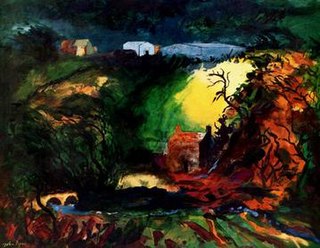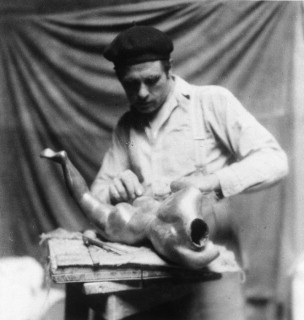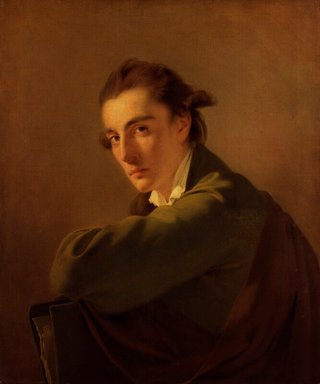Samuel Colman | |
|---|---|
| Born | 1832 |
| Died | 1920 |
| Nationality | British |
Samuel Colman, also Samuel Coleman, (1780 – 21 January 1845) [1] was an English painter, based in Bristol for most of his career.


Samuel Colman | |
|---|---|
| Born | 1832 |
| Died | 1920 |
| Nationality | British |
Samuel Colman, also Samuel Coleman, (1780 – 21 January 1845) [1] was an English painter, based in Bristol for most of his career.


In about 1815 Colman moved from Yeovil to Bristol, where he lived until around 1840. He worked as a portrait painter and drawing-master in the city, as well as painting minutely detailed Romantic, Biblical and genre scenes. [2]
He was a religious Nonconformist who worshipped at the Castle Green Independent Chapel and the Zion Chapel in Bedminster, and his faith was central to his work; [2] some of his paintings, such as his The Destruction of the Temple (Tate Gallery), which shows the ruination of a Gothic cathedral, being criticisms of the Church of England. [3] His apocalyptic paintings have drawn comparisons to those of John Martin. [4]
He signed works as Colman and alternatively Coleman.

Thomas Gainsborough was an English portrait and landscape painter, draughtsman, and printmaker. Along with his rival Sir Joshua Reynolds, he is considered one of the most important British artists of the second half of the 18th century. He painted quickly, and the works of his maturity are characterised by a light palette and easy strokes. Despite being a prolific portrait painter, Gainsborough gained greater satisfaction from his landscapes. He is credited as the originator of the 18th-century British landscape school. Gainsborough was a founding member of the Royal Academy.

Joseph Mallord William Turner, known in his time as William Turner, was an English Romantic painter, printmaker and watercolourist. He is known for his expressive colouring, imaginative landscapes and turbulent, often violent marine paintings. He left behind more than 550 oil paintings, 2,000 watercolours, and 30,000 works on paper. He was championed by the leading English art critic John Ruskin from 1840, and is today regarded as having elevated landscape painting to an eminence rivalling history painting.

Patrick Joseph Caulfield,, was an English painter and printmaker known for his bold canvases, which often incorporated elements of photorealism within a pared-down scene. Examples of his work are Pottery and Still Life Ingredients.
Marc Quinn is a British contemporary visual artist whose work includes sculpture, installation, and painting. Quinn explores "what it is to be human in the world today" through subjects including the body, genetics, identity, environment, and the media. His work has used materials that vary widely, from blood, bread and flowers, to marble and stainless steel. Quinn has been the subject of solo exhibitions at Sir John Soane's Museum, the Tate Gallery, National Portrait Gallery, Fondation Beyeler, Fondazione Prada, and South London Gallery. The artist was a notable member of the Young British Artists movement.

George Stubbs was an English painter, best known for his paintings of horses. Self-trained, Stubbs learnt his skills independently from other great artists of the 18th century such as Reynolds or Gainsborough. Stubbs' output includes history paintings, but his greatest skill was in painting animals, perhaps influenced by his love and study of anatomy. His series of paintings on the theme of a lion attacking a horse are early and significant examples of the Romantic movement that emerged in the late 18th century. His painting, Whistlejacket hangs in the National Gallery, London.
The Norwich School of painters was the first provincial art movement established in Britain, active in the early 19th century. Artists of the school were inspired by the natural environment of the Norfolk landscape and owed some influence to the work of landscape painters of the Dutch Golden Age such as Hobbema and Ruisdael.

Benjamin Lauder Nicholson, OM was an English painter of abstract compositions, landscape and still-life.

Benjamin West, was a British-American artist who painted famous historical scenes such as The Death of Nelson, The Death of General Wolfe, the Treaty of Paris, and Benjamin Franklin Drawing Electricity from the Sky.

John Egerton Christmas Piper CH was an English painter, printmaker and designer of stained-glass windows and both opera and theatre sets. His work often focused on the British landscape, especially churches and monuments, and included tapestry designs, book jackets, screen-prints, photography, fabrics and ceramics. He was educated at Epsom College and trained at the Richmond School of Art followed by the Royal College of Art in London. He turned from abstraction early in his career, concentrating on a more naturalistic but distinctive approach, but often worked in several different styles throughout his career.

English art is the body of visual arts made in England. England has Europe's earliest and northernmost ice-age cave art. Prehistoric art in England largely corresponds with art made elsewhere in contemporary Britain, but early medieval Anglo-Saxon art saw the development of a distinctly English style, and English art continued thereafter to have a distinct character. English art made after the formation in 1707 of the Kingdom of Great Britain may be regarded in most respects simultaneously as art of the United Kingdom.
Graham Vivian Sutherland was a prolific English artist. Notable for his paintings of abstract landscapes and for his portraits of public figures, Sutherland also worked in other media, including printmaking, tapestry and glass design.

Sir Stanley Spencer, CBE RA was an English painter. Shortly after leaving the Slade School of Art, Spencer became well known for his paintings depicting Biblical scenes occurring as if in Cookham, the small village beside the River Thames where he was born and spent much of his life. Spencer referred to Cookham as "a village in Heaven" and in his biblical scenes, fellow-villagers are shown as their Gospel counterparts. Spencer was skilled at organising multi-figure compositions such as in his large paintings for the Sandham Memorial Chapel and the Shipbuilding on the Clyde series, the former being a First World War memorial while the latter was a commission for the War Artists' Advisory Committee during the Second World War.

George Claude Leon Underwood was a British artist, although primarily known as a sculptor, printmaker and painter, he was also an influential teacher and promotor of African art. His travels in Mexico and West Africa had a substantial influence on his art, particularly on the representation of the human figure in his sculptures and paintings. Underwood is best known for his sculptures cast in bronze, carvings in marble, stone and wood and his drawings. His lifetime's work includes a wide range of media and activities, with an expressive and technical mastery. Underwood did not hold modernism and abstraction in art in high regard and this led to critics often ignoring his work until the 1960s when he came to be viewed as an important figure in the development of modern sculpture in Britain.

William James Müller, also spelt Muller, was a British landscape and figure painter, the best-known artist of the Bristol School.

Joseph Highmore was an English painter of portraits, conversation pieces and history subjects, illustrator and author. After retiring from his career as a painter at the age of 70, he published art historical and critical articles.
Bruce McLean is a Scottish sculptor, performance artist and painter.
Paul Feiler was a German-born artist who was a prominent member of the St Ives School of art: he has pictures hanging in major art galleries across the world.

The Bristol School is a term applied retrospectively to describe the informal association and works of a group of artists working in Bristol, England, in the early 19th century. It was mainly active in the 1820s, although the origins and influences of the school have been traced over the wider period 1810–40. During the period of his participation in the activities of the Bristol School, Francis Danby developed the atmospheric, poetical style of landscape painting which then initiated his period of great success in London in the 1820s.

Edward Villiers Rippingille (c. 1790–1859) was an English oil painter and watercolourist who was a member of the informal group of artists which has come to be known as the Bristol School. In that group he was a particularly close associate of both Edward Bird and Francis Danby.

Richard Hurlstone or Richard Hurleston was a British portrait painter known for being a pupil of Joseph Wright of Derby. He went to Italy with Wright and his wife. He returned and died young after being hit by lightning on Salisbury Plain.